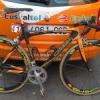Ok, you can also find some information in the academic literature on silymarin and PC (phosph. choline) and bioavailability although most of the work was done back in the early 1990s and so only the abstracts are online. Here is one from the rat:
Eur J Drug Metab Pharmacokinet. 1992 Jan-Mar;17(1):39-44.Links
Comparative bioavailability of Silipide, a new flavanolignan complex, in rats.
Morazzoni P, Magistretti MJ, Giachetti C, Zanolo G.
Inverni della Beffa Research and Development Laboratories, Milan, Italy.
The comparative pharmacokinetics of Silipide (IdB 1016, a silybin-phosphatidylcholine complex) and silybin were investigated by measuring unconjugated and total plasma silybin levels as well as total biliary and urinary silybin excretion in rats following administration of a single oral dose (200 mg/kg as silybin). Mean peak levels of unconjugated and total silybin after IdB 1016 were 8.17 and 74.23 micrograms/ml respectively. Mean AUC (0-6 h) values were 9.78 and 232.15 h.micrograms.ml-1 indicating that about 94% of the plasma silybin is present in a conjugated form. After administration of silybin, plasma levels of both unconjugated and total compound were under the analytical detection limit. Cumulative biliary (0-24 h) and urinary (0-72 h) excretion values after administration of IdB 1016 accounted for 3.73% and 3.26% of the administered dose, respectively. After silybin administration, the biliary and urinary excretion accounted for only 0.001% and 0.032% of the dose respectively. Our results indicate a superior bioavailability of silybin administered orally as IdB 1016. This was due mainly to an impressive increase in gastrointestinal absorption.
and human:
Eur J Drug Metab Pharmacokinet. 1990 Oct-Dec;15(4):333-8.
Pharmacokinetic studies on IdB 1016, a silybin- phosphatidylcholine complex, in healthy human subjects.
Barzaghi N, Crema F, Gatti G, Pifferi G, Perucca E.
Department of Medical Pharmacology, University of Pavia, Italy.
IdB 1016 is a complex of silybin (the main active component of silymarin) and phosphatidylcholine, which in animal models shows greater oral bioavailability and therefore greater pharmacological activity compared with pure silybin and silymarin. In order to assess its pharmacokinetic profile in man, plasma silybin levels were determined after administration of single oral doses of IdB 1016 and silymarin (equivalent to 360 mg silybin) to 9 healthy volunteers. Although absorption was rapid with both preparations, the bioavailability of IdB 1016 was much greater than that of silymarin, as indicated by higher plasma silybin levels at all sampling times after intake of the complex. Regardless of the preparation used, the terminal half-life was relatively short (generally less than 4 h). In a subsequent study, 9 healthy volunteers received IdB 1016 (120 mg b.i.d., expressed as silybin equivalents) for 8 consecutive days. The plasma silybin level profiles and kinetic parameters on day 1 were similar to those determined on day 8. Most of the silybin present in the systemic circulation was in conjugated form. Less than 3% of the administered dose was accounted for by urinary recovery of free plus conjugated silybin, a significant proportion of the dose probably being excreted in the bile. It is concluded that complexation with phosphatidylcholine in IdB 1016 greatly increases the oral bioavailability of silybin, probably by facilitating its passage across the gastrointestinal mucosa.
PMID: 2088770
All indicate increased bioavailability.
I don't yet have details on the PC-silymarin complex but it does sound like its just a 1:1 or 1:2 ratio. I would imagine something similar would be happening for those of us using resveratrol and lecithin........
Here also is the link to the patent #4764508 that describes the "Phytosome" product from my previous post:
http://www.freepaten...om/4764508.html I"ll need to cool my fingers for awhile and will read thru the patent later to get more details.....
Edited by malbecman, 18 December 2007 - 06:15 PM.

















































